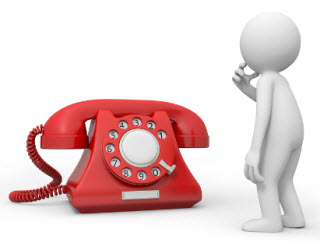During the early 1900s, a telephone was more like an appliance than the pocket sized communication devices of today. There was no such thing as speed dialing – as hard as a person tried, the rotary dial always moved at the same speed. The number one was the shortest pull, as it was closest to the endpoint; and the zero, which was located at the opposite end of the dial, was the longest pull, taking a long trip around the circle of the rotary dial.
Dialing created a whirring sound, of varying lengths for different numbers. Each number represented the number of interruptions to the electrical current to identify the call, and the sound could be identified in the ear piece. Actual bells inside the phone rang, instead of the digitally manufactured sounds of modern cell phones. Hence, “ringing someone” means to call them on the telephone.
The First Rotary Telephones
The first rotary telephone was introduced in 1919. They could be found as a desk telephone with a candlestick, or upright shape. The receiver was held up to the ear while the transmitter, or mouth piece, was built into the telephone stand. Usually two hands were required, to hold the base and the receiver as they were often constructed with heavier materials.
In 1927, the handset model was introduced this convenience allowed the user to have a free hand for taking notes. Both transmitter and receiver were in the handset, which rested in the ‘cradle’ of the phone when not in use. In 1953 the standard Model 500 rotary telephone was introduced. This had numbers outside of the wheel for easier visibility. Over 93 million of these models were produced between 1949 and 1984. While most rotary phones were manufactured in a standard black color, the 1960s introduced phones that could be found in a variety of different colors.
Early Telephone Use
Alexander Graham Bell invented the telephone in 1876. By the 1920s most businesses utilized telephones as a primary form of communication. In the telephone’s early days all individuals in an area would be linked to the same line. This did not give individuals the benefit of having personalized phone numbers, or a sense of privacy. Phone users would pick up the receiver and be connected to their second party through a local operator.
Privacy was later improved through the use of a switchboard. The first switchboard was invented in 1877 by a pharmacist who wanted to easily connect with doctors. Telephone cords with prongs located at the end were plugged into and pulled out of the switchboard to connect and disconnect callers. In a busy office building, the operator had to move fast as there were no telephone extensions and each telephone was equipped with its own number.
The Rotary Phone Today
While the rotary phone is no longer as popular as it once was during the turn of the century, we have it to thank for our current state of communication. Without the rotary phone, we may not have the smartphones of today.
Byline
Hubert Bell is a freelance writer focused on phones, both antique and modern; those with modern phones contemplating phone insurance may want to check out the mobile insurance brand Protect Your Bubble.

